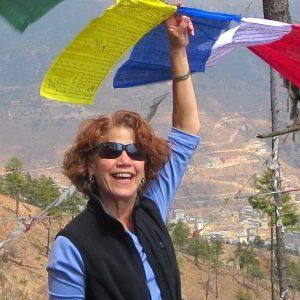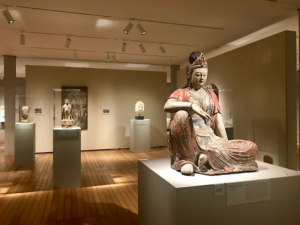
At the Rubin Museum of Art in New York City, veteran art conservator, consultant, and founder of the non-profit organization Treasure Caretaker Training, Ann Shaftel, recently led a “Preservation Retreat for Women Treasure Caretakers.” The information-packed, four-day program, funded by the Frederick P. Lenz Foundation for American Buddhism, was offered free of charge—specifically for women, who are seeking knowledge on caretaking of tangible and intangible heritage treasures.
Shaftel, a devoted Buddhist and highly trained and experienced art conservator, takes a nuanced approach to issues around preserving art objects that are made and blessed for sacred use. As she pointed out: “In these objects, tangible and intangible co-exist all the time.” So how do you handle these material objects—things made up of atoms and molecules—that carry blessings from years of transmissions, empowerments, processions, sacred dance performance, and other ritual use in the hands of or worn by great teachers and practitioners? How do you navigate the work of preservation within the context of Buddhism, with its teachings on impermanence? Shaftel raised the crucial question: “What about the impermanence of Buddhist art?”
To address these complex considerations, she has sought advice from many recognized Buddhist teachers. The esteemed Thrangu Rinpoche counseled, “Religious art is not just for beauty. It is for teaching and developing inner wisdom and compassion.” He went on to say that even when seen out of its traditional context, “such a viewing plants a seed of merit in the viewer.” In a similar vein, the current Kalu Rinpoche reflected that sacred art is providing refuge to all sentient beings—wherever it is and regardless of its condition.

Given this thinking, how does one care for sacred objects such as textiles and paintings touched by years of traditional usage. Exposure to sunlight, smoke from butter lamps and incense, offering substances, human sweat, rain, and so on, can clearly cause damage. Shaftel cautioned: “Sacred use includes touching and sprinkling, and it’s not dirty. Darkened or stained thangkas should not be deep cleaned with solvents, as is typical in restoration methods used for Western art. You are just destroying the hand of the master and removing the evidence of blessings.” She recommends a preservation model based on stabilization, documentation, and prevention. For historic thangkas, this may mean stabilizing structural damage where necessary and safely storing the piece. Then one can commission a new thangka for ritual use by copying the old one using digital restoration methods to accurately render the original iconography.
At the Rubin Museum, the workshop got off to an energizing start as attendees toured the galleries with an eye toward the presentation of the works. Participants congregated around works of their choosing and Shaftel prompted thoughtful discussion. Was the artwork displayed with unobtrusive mounts? Were objects well-lit and without glare? Were they well-placed in relation to other objects with which they are supposed to be in conversation? Were items displayed with informative context regarding their use?
Lectures on the conservation of sacred art brought to light differences between working practices in museums and those in monasteries and Dharma centers. Shaftel has a wealth of knowledge from 54 years of hands-on work in monasteries, museums, universities, Dharma centers, and private and corporate collections. Through the Treasure Caretaker Training program, founded in 2015, Shaftel translates this expertise into training for monastics and laypeople in the Himalayan region and diasporic communities, empowering them as effective caretakers of their Buddhist treasures. In her ongoing work in both urban and extremely remote locales, Shaftel has developed a notably minimalist approach to conservation—one that respects the art, its use, and the ideas and wishes of the community in which it is held. Her unique method of training caretakers of Buddhist treasures empowers communities to document, assess for risk and damage, and respond in a manner respectful of the sacred nature of the objects.

Prevention is the most cost-effective method of art conservation. Having a disaster preparedness plan in a region prone to earthquakes, fires, and landslides is important and sensible. Creating safer storage techniques is another low-budget intervention that can lengthen the life of many items, such as dance costumes that are frequently packed away for a year while still sweaty or soaked from rain. Merely taking the time to thoroughly air-dry them before folding and packing for storage can make a huge difference.
However, it all starts with documentation. Diving into this process, participants were invited to assess and document art pieces from Shaftel’s teaching collection using simple smartphone documentation techniques. Lively discussion ensued as everyone’s phone cameras were trained on damage from stains, improper storage (folding), sunlight, ripped seams, missing parts, and so on. Stressing the importance of documentation in the preservation of sacred art, Shaftel underscored how this basic intervention: safeguards the object’s significance and context; improves the object’s value; provides access to information about the treasure even if the object is no longer available; and proves legal ownership in the event of theft, fire, or earthquake.
An essential aspect of treasure documentation is the gathering of oral histories. As elders in these Himalayan communities are the traditional keepers of memory treasures, documenting their oral histories while they are alive is an imperative. Workshop participants partnered up to role play best practices for video interviewing of elders. Shaftel made the point that documentarians are in a unique position to help elders appreciate the value of their treasure and motivate them to think about how they might pass on their treasures meaningfully after they pass away.
With the help of the Rubin Museum’s Community Ambassador Tashi Chödrön, the workshop expanded into the realm of community building and welcomed a visiting group of high school and college students from Adhikaar, a New York-based Nepali service organization. Shaftel immediately connected with the young people, encouraging them to use their smartphones and digital knowhow to document their grandparents’ and parents’ stories. Eyes lit up as she challenged some to experiment with digital restoration of faded artwork.

On the final day, the workshop made a stop at Ouovo Fine Art Storage to tour the Rubin Museum’s state-of-the-art storage facility. The roomy 372-square-meter space is equipped with five-meter painting racks hung with several hundred framed thangkas, shelves of storage materials, others with wrapped wooden masks and small metal statues, tall boxes with clay statues, and large modular worktables with slender drawers filled with every imaginable kind of tool and packing supply.
But nothing could match the vibrancy of the trip through New York City’s mix of cultural communities. The workshop group dropped in on a Himalayan Buddhist day camp run by the Danang Foundation. There, Shaftel captivated the young campers with her stories of growing up in a nearby neighborhood in Queens, going to public school, and later meeting the 16th Karmapa at a formative moment in her life. Just as His Holiness advised Shaftel to make her life’s work about preserving Buddhist treasures, she encouraged the young ones to dream big and start being curious about the history of the objects on their home shrines.
A visit with the elders at the Himalayan Sherpa Temple and Community Center provided another opportunity for community activation and empowerment. The elders, mostly dressed in traditional Tibetan chuba and aprons, had gathered for a day of religious and social activity. Fingering their malas, they gathered in the prayer hall and listened to Shaftel’s appeal to impart the stories of their treasures to the younger generations in their households. She offered her WhatsApp number in case they had questions about caring for their items.
In each setting, Shaftel connected directly with the audience before her, making the case for documenting their religious and cultural treasures. Workshop participants and community members felt inspired by her passion for this work and left with a sense of responsibility fostered by a new awareness of the abundance of intangible blessings permeating so many of the tangible objects in our care.

See more
Treasure Caretaker Training: The Preservation of Buddhist Treasures Resource
Danang Foundation
Adhikaar
Related features from BDG
Buddhism in the Hidden Valley, Part 1: An Ancient Heritage in Tsum
Buddhism in the Hidden Valley, Part 2: Heritage Conservation in Tsum
Buddhism in the Hidden Valley, Part 3: An Interview with Khenpo Karma Samdup on the Legacy of Kenchen Thrangu Rinpoche
Buddhism in the Hidden Valley, Part 4: Conservation and Community at Rachen Gompa
Buddhism in the Hidden Valley, Part 5: In Conversation with Rachen Gompa’s Geshe Tenzin Nyima
Related videos from BDG
Buddhist Heritage: Conservation and Creation (BDG YouTube)












